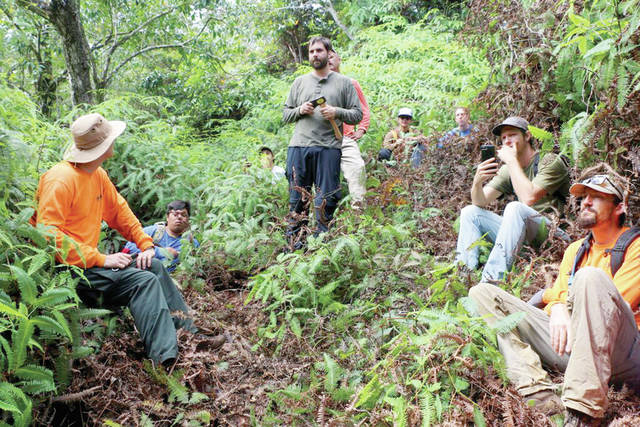LIHUE — Rapid Ohia Death has been confirmed at two more locations on Kauai since the May discovery of the disease in the island’s native trees.
The fungal pathogen that has been killing ohia trees on Hawaii Island was discovered in 14 trees in Moloa’a in early May and since then, three more trees have tested positive for the fungus. Those trees are located on privately owned land in Halelea Moku and near the Lihue-Koloa Forest Reserve.
This identifies ROD at three distinct locations on Kauai at elevations ranging from 600 to 1,600 feet above sea level.
New to science, understanding of the disease has evolved along with the number of trees affected by it and on Hawaii Island, scientists at the U.S. Department of Agriculture identified the two-different species of fungi that cause ROD, C. huliohia and C. lukuohia.
“At this point, only one of the two fungal pathogens have been confirmed on Kauai,” said Melissa Fisher, Kauai forest program director, The Nature Conservancy. “Now we need everyone to be extra vigilant to prevent further spread of the existing disease and help to keep the other ROD-causing pathogen off our island as well.”
The new detections of ROD are the same strain of fungal pathogen that was detected in the trees at Moloa’a — the less virulent of the two species, Ceratocystis huliohia.
After that May detection of ROD in Moloa’a, research partners started an effort to locate any more trees with the fungus and to understand the disease itself.
“We are finding trees with ROD now because we are searching for them,” said Sheri S. Mann, Kauai branch manager for the DLNR Division of Forestry and Wildlife.
Detecting ROD on Kauai brought that search to the island, and teams conducted aerial drone flights and helicopter surveys using digital mobile sketch mapping and identified 22 areas on Kauai on state and private lands with ohia trees showing symptoms consistent with the disease.
So far in 2018, 76 samples from Kauai have been collected and submitted for lab testing, with more being added every day, according to Tiffani Keanini, project manager of Kauai Invasive Species Committee.
And the collaboration has been quick between agencies like the Department of Land and Natural Resources, KISC, The Nature Conservancy, National Tropical Botanical Garden, Kauai Watershed Alliance, and the University of Hawaii.
“After recent detection we have been working together with this amazing slew of partners to identify what areas need to be sampled because they have highly suspect trees,” Keanini said.
Since ROD was identified on Hawaii Island more than four years ago, it has affected more than 135,000 acres of ohia forest.
On Kauai, ohia are relegated to forested areas, and any loss is detrimental to endangered native birds and other plants, insects and animals that rely on them for survival.
Research partners have made significant progress in understanding the disease, and one of the biggest is how the fungus enters trees, with the role of burrowing beetles under scrutiny as well as other factors.
Once the fungal spores enter the trees, the disease advances by cutting off the tree’s flow of water.
“It’s clear that both fungal species enter trees through wounds, as do many other tree diseases, so it’s important not to wound them by taking clippings, trimming, or stepping on roots,” said Keanini.
She continued: “The next layer of defense is to avoid spreading the fungus by scrubbing all footwear clean of mud and spraying with 70 percent isopropyl alcohol after any forest activity, washing all gear and clothing, and thoroughly washing any equipment and vehicles — especially tires — that enter or are used in the forest, along roadsides, or off road.”
•••
Jessica Else, environment reporter, can be reached at 245-0452 or at jelse@thegardenisland.com
Learn about Rapid Ohia Death
Several meetings are upcoming on Kauai to help bring the public up to speed on Rapid Ohia Death.
On Wednesday, Dec. 12, from 1 to 3:30 p.m., land-based tour operators are encouraged to attend a free workshop on how to prevent the spread of Rapid ʻOhia Death. The course covers best sanitation practices for tour operators so guides and guests can feel confident about minimizing their impact on native landscape. The workshop will be held at the Kauai Agricultural Research Station at 7370-K Kuamoo Road in Kapaa. Sign up at www.rapidohiadeath.org. Registration is required.
People can learn more about ohia, its role in the culture, and ROD on Tuesday, Dec. 11, starting at 5:30 p.m., at the Kauai premier of “Saving ‘Ohiʻa.” The documentary is part of the collaborative National Tropical Garden-Kauai Community College ‘Earth Matters’ public lecture series and will air in the KCC Campus Center Cafeteria.




Wild pigs and goats certainly have a negative impact on spreading this ROD fungus. How about those mountain bikes and 4 wheel machines that tear through Hawaii’s forests, it should also be banned not just for ROD, but the environmental damage they do to induce excessive flooding and erosion. Zip lines also is a negative factor
yeah, good point, Harry. Tourists are to blame for this, too.
I mean, soaring through the canopy, well above the ground,
is definitely having a negative impact on the ground below.
-We should ban tourists, that’ll solve all of Kauai’s problems.